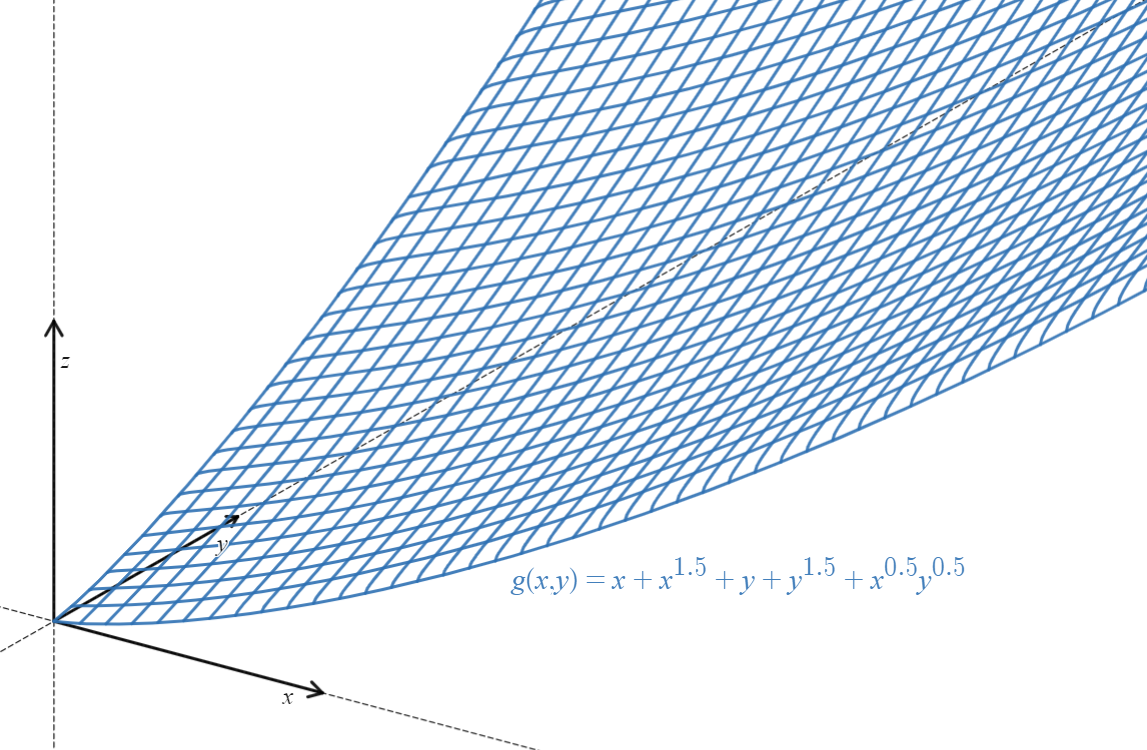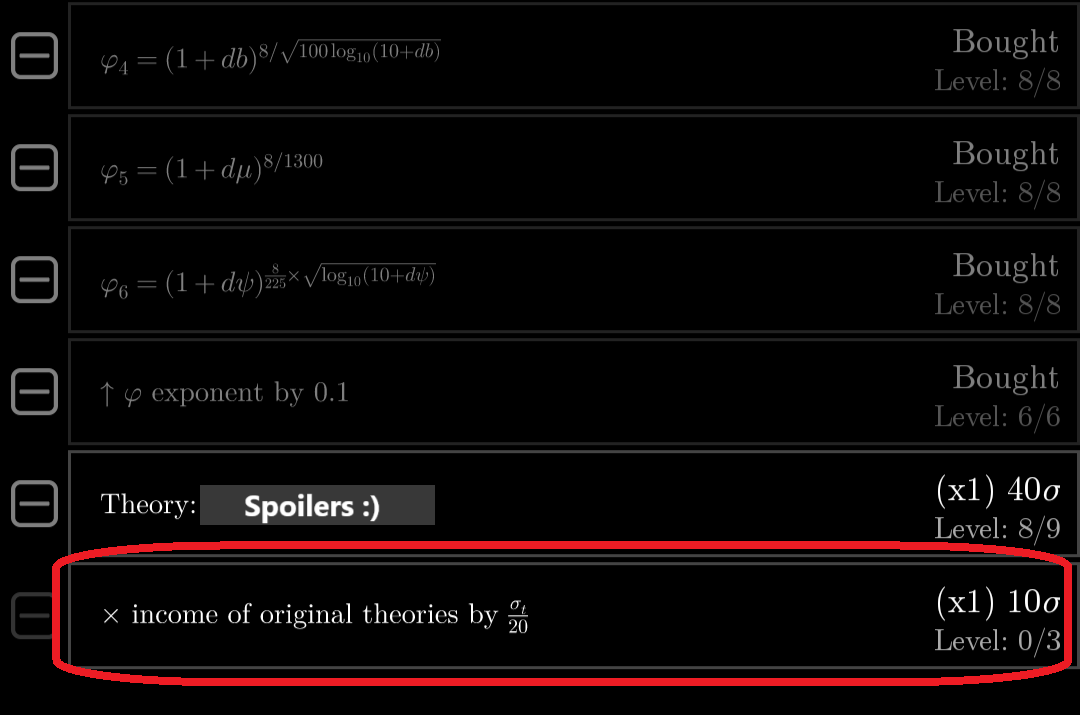Theories 5-8
This guide is currently undergoing change. Keep in mind, strategies may change.
Feel free to use the glossary or T5-7 T8-R9 as needed.
Graduation routing #
Remember to follow our routing advice from the introduction to graduation.
Class: graduation_routing;
last_row: false;
| 9k | ARROW | 9.4k | ARROW | 9.8k | ARROW | 10k |
| 10k | ARROW | 10.4k | ARROW | 10.6k | ARROW | 11k |
| 11k | ARROW | 12.4k | ARROW | 13.4k | ARROW | 14k |
| [style=“text-align: center;”;]Skip T8 | ||||||
| 14k | ARROW | 14.8k | ARROW | 15.6k | ARROW | 16k |
| 16k | ARROW | 16.8k | ARROW | 18k | INVIS | INVIS |
| 18k | ARROW | 20k | INVIS | INVIS | INVIS | INVIS |
Theory 1 #
You will not touch this theory until after ee14k. Once you begin pushing T1 after ee14k, begin using the Theory Sim and the Theory Sim Guide to give the best strategy and multiplier for the next publication.
Theory 2 #
This theory will be used as overnight until 1e350
Theory 3 #
See our earlier guide for an overview for theory 3.
Theory 4 #
See our earlier guide for an overview for theory 4.
Theory 5 (40σ / 9k) #
Theory 5 Overview #
The optimal publish multiplier for T5 is between 2-3 and 6-10, please check with The Sim for accuracy. Theory 5 is based on logistic function. This theory is slow early, but becomes very powerful later on in the game. It is recommended to keep pushing this theory as high as possible before reaching ee14k ft. Make sure to carefully read the behavior of c1 and c2 variables in this theory, as the behaviors are quite unique.
Theory 5 Equation Description #
The first line states that the rate of change of
The second line defines this theory. It describes the behavior of a typical logistic function. A logistic function typically has slow growth at the beginning, then fast growth in the middle, then it flattens out at the end. Here we have
The maximum value of
Approximate variable strengths on
Class: variable_description;
Caption: Brief summary of variable strengths of Theory 5.;
last_row: false;
| Variable Description | |
|---|---|
| ~7% increase on |
|
| Doubles |
|
| Doubles the maximum value of |
|
| Doubles the maximum value of |
Bicycle Analogy (alternative explanation) of c1 and c2 interactions #
Think of buying
If all one does is buy
Therefore using the bicycle analogy, buy
When deciding when to buy
Theory 5 strategy #
The strengths of each variable are as follows:
Note that
Manual buying c2 - READ THIS BEFORE DOING THE STRATEGIES #
For step 2 of the semi-idle and active strategies below, you should be manually buying
You want to buy
- Buy
. should increase. - Once
increases slowly (or stops increasing), buy more .
If you buy a
Once you’ve reached within
Idle #
It is not recommended to idle theory 5 (see explanation on
For each publication: autobuy
- For the first 10 seconds, autobuy everything except
. - Afterwards, simply autobuy all until publish.
Semi-Idle #
Semi-idle is similar to idle, but once the theory is recovered, manual buy
For each publication: autobuy
- For the first 10 seconds, autobuy everything except
. - Then we want to manually buy
. See Manual Buying c2. Do this until it slows down and you’re within ~ under last publication mark. - Then we autobuy all until
has reached its previous publication value (finished recovery). - Afterwards, deactivate
and autobuy the rest until publish.
Active #
Here’s a simple yet effective active strategy that can be used right until endgame. To find more optimized strategies, please see the List of theory strategies.
For each publication: autobuy
Note that for faster speed, during the first part of step 2, 10 levels can be bought at a time.
- For the first 10 seconds, autobuy everything except
. - Then we want to manually buy
. See Manual Buying c2. - Then we autobuy
. Out of these 3 variables, find the one with the cheapest cost. Then buy until its cost exceeds 15% of the cheapest variable found above. Buy ONLY right after buying a level of . - Once the theory has recovered to its previous publication mark, slowly put less emphasis on
. When in doubt, have ’s cost be similar to ’s cost. Continue doing step 2 until publish.
Theory 5 milestone route #
All milestones into the 2nd milestone to unlock
Class: milestone_routing;
last_row: false;
| 0/1/0 | ARROW | 3/1/0 | ARROW | 3/1/2 |
Commentary
(By Snaeky)
No commentary
(By Snaeky)
(By Playspout)
T5 will always give its best results from active play. However, after step 3, you can still get good results while autobuying
Warning: Do not overnight this theory. It has terrible decay after passing a good publication mark and will not give good results. T5i is only viable very late/endgame.
Additional information #
Purchase
the number of milestone 3.
Strategy constructed by: Snaeky, Marks, Baldy, and Nerdy
Theory 6 (45σ / 10k) #
T6 Overview #
T6 has the lowest decay of all the theories. It will be second place to T5 until ~
At first, T6 only finds the area under the curve of the graph
For example, let the integral equal 10, and you buy an upgrade that costs
* This is not the same as the sum of the cost of all
T6 strategy #
The optimal multiplier varies between 6-12, but spikes depending on what variable is dominant at the time and how close you are to a milestone. For an accurate multiplier, check with the sim.
Class: breakdown;
last_row: false;
Caption: T6 Strategy;
| [class=“category”;]Idle | |
| [style=“text-align:left;”;]Buy All. | |
| [style=“text-align:left;”;]Turn off |
|
| [style=“text-align:left;”;]Turn off |
|
| [style=“text-align:left;”;]Turn off |
|
| [style=“text-align:left;”;]Turn off |
|
| [class=“category”;]Active | |
| [style=“text-align:left;”;]Buy All with |
|
| [style=“text-align:left;”;]Buy |
|
| [style=“text-align:left;”;]Buy |
|
| [style=“text-align:left;”;]Buy |
|
| [style=“text-align:left;”;]Buy |
T6 milestone route #
Class: milestone_routing;
last_row: false;
| 0/0/0 | ARROW | 0/1/0 | ARROW | 1/1/0/0 |
| 1/1/1/0* | ARROW | 1/0/0/3 | ARROW | 1/0/1/3 |
| 1/1/1/3 | INVIS | INVIS | INVIS | INVIS |
Class: milestone_routing;
last_row: false;
| OR | INVIS | INVIS | INVIS | INVIS | INVIS | INVIS |
| 2 | ARROW | 1 | ARROW | 3 | INVIS | INVIS |
| 3 | ARROW | 4* | ARROW | 3 | ARROW | 2 |
| [FOOT;]* Swap 1/1/1/0 → 1/0/0/3 |
Theory 7 (50σ / 11k) #
T7 overview #
T7 can be summarized as a maximization problem : given a surface in 3-dimensional space, you want to find its highest altitude by moving along the surface, always in the direction of steepest ascent (that’s basically a gradient ascent). The function

This is the graph of the function
Note: here, coefficients like
T7 strategy #
The optimal publication multiplier is
T7 milestone route #
Class: milestone_routing;
last_row: false;
| 0/0/0 | ARROW | 0/1/0 | ARROW | 0/1/1 |
| 0/0/2* | ARROW | 0/0/3 | ARROW | 0/1/3 |
| 1/1/1/1/1** | ARROW | 1/1/1/1/3 | INVIS | INVIS |
Class: milestone_routing;
last_row: false;
| OR | INVIS | INVIS | INVIS | INVIS |
| 2 | ARROW | 3* | ARROW | 3 |
| 2 | ARROW | 1** | ARROW | 3 x2 |
| [FOOT;]* Swap 0/1/1 → 0/0/2 at ~ |
||||
| [FOOT;]** Swap 0/1/3 → 1/1/1/1/1 |
Theory 8 skipping #
Temporarily skipping T8 is significantly faster than buying T8 right away because of how slow T8 is from
Class: strat;
Caption: T8 skip
| INVIS | Idle | Active |
|---|---|---|
| T1 | ||
| T2 | ||
| T3 | ||
| T4 | ||
| T5 | ||
| T6 | ||
| T7 | ||
| T8 | ||
| [FOOT;style=“width:25vw;”;]If your numbers are different, that is fine. You just need to reach |
Student routing with R9 #
All routing follows the student calculator (by Niedzielan, AfuroZamurai, and Milla) and
star calculator (by Eaux Tacous#1021). When you are not pushing
There is also the theory simulator originally by XLII and now developed by the Exponential Developers, which works both below max milestones and after max milestones for all theories.

How to push F(t) with R9 swapping #
Memorize your student distributions with and without 10/20/30 R9 students. Use the student calculator if needed. You will commonly see people refer to this as R9 seaping as a long held name of the strategy.
- Wait till
stops growing with students in R9 pushing . - Start accel (preferably keep it between prestiges).
- Potentially sit here to stack t for bigger
when you have students in . Only do this when you are near a graduation mark. This is not useful if you will not swap into . - Respec all 10/20/30 students from R9.
- Wait for the autoprestige to prestige and swap back students to R9.
- Repeat.
This method allows you to push
R9 autoprestige expression #
You can find the autoprestige used for R9 Swapping here: Equation. If you don’t have this expression, then you will have to manually prestige each swap.
Reference R9 Swapping Autoprestige Explanation
Theory 8 (55σ / 12k) #
T8 strategy #
The optimal publication multiplier is 2.5-5 depending on how close you are to the next milestone. This theory is extremely slow at the start which is why we skip until we obtain R9. It is also the only one with a
At the start, manual buy prioritizes
Class: breakdown;
Caption: T8 Attractor Information;
| INVIS | Starting Positions | Time Step |
|---|---|---|
| Lorenz | (-6, -8, 26) | 0.02 |
| Chen | (-10.6, -4.4, -28.6) | 0.002 |
| Rössler | (-6, 15, 0) | 0.00014 |
T8 milestone route #
Class: milestone_routing;
last_row: false;
| 0/0/0/0 | ARROW | 1/0/0/0 | ARROW | 2/0/0/0 |
| 0/0/0/2* | ARROW | 0/0/0/3 | ARROW | 1/0/0/3 |
| 2/0/3/0** | ARROW | 2/3/3/0 | ARROW | 2/3/3/3 |
Class: milestone_routing;
last_row: false;
| OR | INVIS | INVIS | INVIS | INVIS | INVIS | INVIS |
| 1x2* | ARROW | 4 | ARROW | 1 | ARROW | 1** |
| 1 | ARROW | 2 x3 | ARROW | 4 x3 | INVIS | INVIS |
| [FOOT;]* Swap 2/0/0/0 → 0/0/0/2 at |
||||||
| [FOOT;]** Swap 1/0/0/3 → 2/0/3/0 |
Final Push to ee20k #
In general, you will need ~
Class: strat;
Caption:
| INVIS | Idle | Active |
|---|---|---|
| T1 | ||
| T2 | ||
| T3 | ||
| T4 | ||
| T5 | ||
| T6 | ||
| T7 | ||
| T8 | ||
| [FOOT;style=“width:25vw;”;]Being above or below these values is fine, just as long as you have ~ |